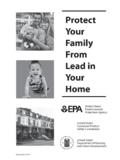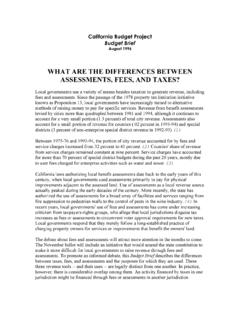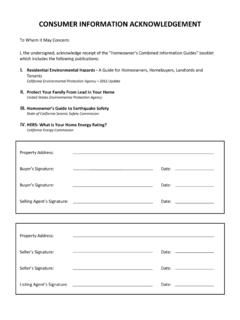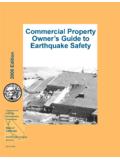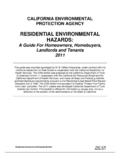Transcription of Homeowner’s Guide to Earthquake Safety - Disclosure Source
1 homeowner sGuide toEarthquakeSafetyBefore EarthquakePublished byThe CaliforniaSeismic SafetyCommissionState ofCaliforniaArnoldSchwarzenegger,Governo rSSC No. 05-012005 EditionDamage from magnitude earthquakeAdditional damage from aftershocks Publishing InformationThe homeowner s Guide to Earthquake Safety was developed andpublished by the California Seismic Safety Commission. The Guide wasprepared for publication by the staff of The Collaborative for DisasterMitigation, San Jose State University, One Washington Square, SanJose, CA 95192-0082. It was distributed under the provisions of theLibrary Distribution Act and Government Code Section 2005 by the California Seismic Safety CommissionAll rights reservedLegislationThis Guide has been developed and adopted by the California SeismicSafety Commission as required by Assembly Bill 2959, authored byAssemblyman Johan Klehs (Chapter 1499, Statutes of 1990), andAssembly Bill 200, authored by Assemblyman Dominic Cortese (Chapter699, Statutes of 1991).
2 Ordering InformationCopies of this booklet are available from the California Seismic SafetyCommission, 1775 Creekside Oaks Drive, Suite 100, Sacramento, CA95833. To order call (916) 263-5506 or download via our website the cover:Taken in Coalinga, California, the pictures of this single family homeshow the destruction caused by the Coalinga Earthquake on May 2,1983. The magnitude Earthquake inflicted severe damage to theunreinforced masonry porch, forcing the occupants to aftershocks occurred within the next few days, causingportions of the already weakened structure to homeowner s Guide to Earthquake SafetyThis 2005 Edition of the homeowner s Guide to EarthquakeSafety replaces the 2002 Edition on July 1, Home and the of Major California Tax and of Damage to Single Family MAPS OF Earthquakes in Earthquake Faults in Earthquake Shaking Potential Mapfor Water Not Anchored to Cripple and Post Masonry Built on Steep Masonry over Earthquake -RELATED Masonry with Unique THE WORK TO DO DURING AN TO DO BEFORE AN TO DO AFTER AN Earthquake HAZARDS TAX EXCLUSION homeowner s Guide to Earthquake SafetyiiiACKNOWLEDGMENTSivThe homeowner s Guide to Earthquake SafetySeismic Safety CommissionLucille M.
3 Jones, , Chair, SeismologyHon. Richard Alarcon, State Senate (Chris Modrzejewski)Hon. Carol Liu, State Assembly (Donald Manning)Lawrence T. Klein, UtilitiesMark Church, Local GovernmentLinden Nishinaga, , City GovernmentCelestine Palmer, InsuranceAndrew A. Adelman, , Cities/Building OfficialStan Moy, , Architecture and PlanningDaniel Shapiro, , Structural EngineeringVacant, Mechanical EngineeringBruce R. Clark, , GeologyVacant, County GovernmentVacant, Emergency ServicesDonald R. Parker, Vice Chairman, Fire ProtectionJimmie R. Yee, Social ServicesVacant, Soils EngineeringSeismic Safety Commission StaffRichard McCarthy, Executive DirectorRobert AndersonKaren CoganHenry ReyesHenry SepulvedaFred Turner, Project CoordinatorSue CelliRebecca RomoCollaborative for Disaster Mitigation StaffGuna Selvaduray, , Executive DirectorPatrick Chong, WebmasterCrystal Carrera, Administrative AssistantThe Commission gratefully acknowledgesthe assistance of the following.
4 American Red CrossAmerican Society of Home InspectorsAssociation of Bay Area GovernmentsBuilding Education CenterCalifornia Association of RealtorsCalifornia Building OfficialsCalifornia Council of the American Institute of ArchitectsCalifornia Geological SurveyCalifornia Real Estate Inspection AssociationCalifornia Governor s Office of Emergency ServicesCity of Los AngelesEarthquake Engineering Research InstituteHumboldt Earthquake Education CenterInternational Code CouncilSBCSan Diego Association of GovernmentsSouthern California Association of GovernmentsSouthern California Association of ResidentialRetrofit ProfessionsSouthern California Gas Company/SempraStructural Engineers Association of CaliforniaCommittee on Earthquake Safety Issues for GasSystemsDisclaimer: The effects, descriptions, recommendations, andsuggestions included in this document are intended to improveearthquake preparedness; however, they do not guarantee thesafety of an individual or a structure.
5 The Seismic SafetyCommission takes responsibility for the inclusion of material inthis document. The State of California, the Seismic SafetyCommission, and all contributors to this document do notassume liability for any injury, death, property damage, loss ofrevenue, or any other effect of an , especially major ones, aredangerous, inevitable, and a fact of life inCalifornia. Sooner or later another big one : Occur without warning Can be deadly and extremely destructive Can occur at any timeAs a current or potential owner of a home*, youshould be very concerned about the potentialdanger to not only yourselves and your loved ones,but also to your major threats posed by earthquakes are bodilyinjuries and property damage, which can beconsiderable and even of the property damage caused byearthquakes ends up being handled and paid forby the homeowner . Earthquakes have caused over $55 billion inlosses in California since 1971.
6 Large earthquakes in or near major urbancenters in California will disrupt the localeconomy and can disrupt the economy of theentire , proper Earthquake preparation of yourhome can: Save lives Reduce injuries Reduce property damageAs a homeowner , you can significantly reducedamage to your home by fixing a number of knownand common homeowner s Guide to Earthquake Safety1*For the purpose of this document, home includessingle family residences, duplexes, triplexes, Booklet is designed to assist you in filling outthe Residential Earthquake Hazards Report (Seepage 47) when you sell your booklet is also a good start to beginstrengthening your home against describes: Common weaknesses that can result in yourhome being damaged by earthquakes, and Steps you can take to correct are no guarantees of Safety duringearthquakes, but properly constructed andstrengthened homes are far less likely to collapseor be damaged during earthquakes.
7 The CaliforniaSeismic Safety Commission advises you to act onthe suggestions outlined in this booklet and makeyourself, your family, and your home State Law requires theseller to: Inform the buyer about known homeweaknesses (See EarthquakeWeaknesses, beginning on page 11). Strap the water heater, reducing thechance of it falling during an earthquakeand possibly causing gas and water lines tobreak. Deliver a copy of this booklet to the buyer ifthe home was built before 1960 ( your realestate agent is required to give the seller acopy of this booklet). Deliver to buyers a Natural HazardsDisclosure form (See page 4). Thedisclosure will tell buyers whether the homeis in an Earthquake Fault Zone or in aSeismic Hazard Zone (See page 38) Complete the Residential EarthquakeHazards Report, to be provided to thebuyer (See page 47).California State Law does not requirethe seller to: Hire someone to evaluate your home.
8 Strengthen your home before selling homeowner s Guide to Earthquake SafetyThis Booklet: Describes the most common weaknessesthat can cause damage to homes, in theevent of an Earthquake . Enables the seller to meet the State Lawrequiring this booklet be given to everybuyer of homes built before 1960. Enables the seller to disclose to the buyerthe typical Earthquake weaknesses inhomes built before 1960. Provides the homeowner with basicinformation about finding and fixingearthquake-related weaknesses in thehome. Provides general information aboutearthquake risks and directions for findingmore information on Earthquake HOME AND THE You Are SellingBefore you sell your house, the following stepsare recommended: If you list your house for sale through a realestate broker or agent, give the agent thecompleted Disclosure form (See page 47)as soon as practical. your agent can givethe booklet and the form to the buyer foryou.
9 You are not required to hire someone toanswer the questions on the disclosureform. You are not required to remove siding,drywall, or plaster to answer the questions. You are not required to fix the weaknessesbefore you sell your home. However, if you wish, you may getassistance from a certified home inspector,or a licensed contractor, architect, orengineer. Keep a copy of the form, signed by thebuyer, as evidence that you have compliedwith the Earthquake may find that you will get a better price foryour house if you strengthen earthquakeweaknesses before you You Are BuyingBefore you agree to buy a house, consider thefollowing recommendations: Have a certified home inspector, licensedbuilding contractor, architect, or engineerinspect the house and give you an opinionregarding existing Earthquake weaknessesand an estimate of costs to strengthenthese weaknesses.
10 Consider the location of the home: Is it in ornear an Earthquake Fault Zone or in anarea where it might be damaged by alandslide, liquefaction, or a tsunami? Youmay wish to hire a licensed geotechnicalengineer and/or engineering geologist tocheck the stability of the land under thehouse. Negotiate the cost of strengthening, if anyis required, with the seller. The law doesnot require either you or the seller tostrengthen the home, but if these weak-nesses are not fixed, you may find thatrepair costs after a damaging earthquakecan amount to more than your equity in homeowner s Guide to Earthquake Safety34 The homeowner s Guide to Earthquake SafetyDelivering this guideSellers of homes built before 1960, with one to fourunits of conventional light-frame construction,must deliver to the buyer, as soon as practicablebefore the transfer, a copy of The homeowner sGuide to Earthquake Safety (this booklet) anddisclose certain Earthquake deficiencies accordingto Government Code, Section to seller s real estate agent must provide theseller with a copy of this booklet to give to thebuyer.
